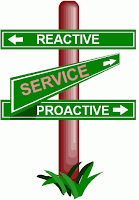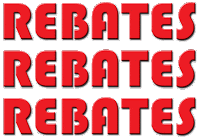A Few Thoughts on The Reactionary Sales Model
 Talk to any sales manager and they will tell you they
want their team to be proactive.
Proactive as in sales calls, targeting, prospecting and product
introductions. Planning and setting
detailed customer-centric goals is also viewed as proactive. Sales managers preach proactivity. Detailed studies of distributor salespeople,
however, reveal a lot of folks who are anything but proactive. In spite of the directives from their
managers, a lot of these guys seem happy in their roles.
Talk to any sales manager and they will tell you they
want their team to be proactive.
Proactive as in sales calls, targeting, prospecting and product
introductions. Planning and setting
detailed customer-centric goals is also viewed as proactive. Sales managers preach proactivity. Detailed studies of distributor salespeople,
however, reveal a lot of folks who are anything but proactive. In spite of the directives from their
managers, a lot of these guys seem happy in their roles.
Defining Reactionary Sales…
A good many knowledge-based distributor salespeople have
quietly slipped into what I call the reactionary sales model. Here is the premise of their system:
·
The seller becomes engaged with the customer. Sometimes this is an inherited relationship,
other times, it builds gradually over time as the seller proves their worth as
a provider of sound advice, support and technical assistance. The seller builds
a level of trust and becomes one of those called in to assist in problem
solving and solution building.
·
The seller becomes available on demand. The deeper the relationship, the more
available the seller becomes as a source of advice and assistance. It is not
uncommon for sellers working in this mode to drop whatever proactive plans they
may have developed to run to their customer’s location at a moment’s
notice. This activity is typically
rewarded emotionally with appreciative words and with a regular stream of
orders.
·
The seller develops deep loyalties with
customers. As loyalty builds, the
customer begins moving business to the salesperson’s company and business
grows.
Sounds pretty good so far….
But there is more, maybe even vindication. A recent study of engineers in the OEM side
of our business reveals much about the way our industry sells. Three things are made clear in the study:
1.
Engineers prefer to request information – “don’t
call us we’ll call you”.
2.
Once a salesperson is established as a source of
information – they call often.
3.
Local and Regional Distributors are viewed as
better sources of information than National Chains (something we have always
known but didn’t have the data to prove.)
But there are problems…
The story doesn’t end with “they all lived happily ever
after” because there are some issues standing in the way of great
business. While time and the nature of
this post don’t lend themselves for a detailed study, we should touch on the
issues.
·
This model takes time. Engaging with customers, proving yourself and
building trust take time; probably measured in years. How long can a salesperson wait for business
to come?
·
Distributors lose customers by attrition. Depending on the expert, between five and ten
percent of our customers drop off each year.
We’re not speaking of business lost to competitors; instead customers go
out of business, are purchased by another organization or move to another
location. When this happens, it takes a
long time for a reactive guy to replenish their customer base.
·
Reactive salespeople are slow to introduce
new products and technologies. When
salespeople operate in the reactive mode, they wait for the customer to request
information. Since the customer has
someone else providing assistance with the new line of technology, the time to
introduce new products is painfully slow (years.)
·
Reactive salespeople struggle to justify
which account receives their high quality reactive service. Oftentimes, reactive salespeople peak out
early. One of the main causes is they
run out of time. This level of service
takes time. If they don’t “justify”
their time against customer potential or business volumes, they get consumed by
helping accounts which cannot provide the necessary volume to fuel their
business. Since the emotional reward can
be high from small accounts, who thank them profusely for their assistance,
they struggle to prioritize their time.
By now the point should be clear, the reactive model
works but does not align itself with the goals of most distributors. Expansion into new product technologies is
hampered and organic growth is slow (even if arguably steady.)
Improving the situation…
If your team is overloaded with reactive mode sellers,
you must answer this lucky seven list of questions:
1. How
can we speed up the relationship process?
We’ve determined the reactive seller is good once a relationship is
built. But, they need help with jump
starting the relationship.
2. How
can we help focus their efforts?
Most sellers don’t track their time, even though CRM Systems are good
tools. If we can help them understand
the value of their time, they may refocus energies on accounts with greater potential.
3. Can
we develop tools for introducing new products? Training is the new marketing. Are you exploring all the opportunities to
increase your training portfolio?
4. Are
add on products well understood? If
the salesperson is assisting the customer with a solution, do they understand
the nuances of expanding the products by providing a bigger piece of the
solution?
5. Does
the reactive seller know how to leverage existing contacts to expand their
customer contact base? Since the
time to build trust and establish a relationship is long, we need to find ways
to leverage the relationship. Does the
seller ask his contacts for referrals within their company? Does the reactive guy understand the
importance of knowing everyone within their account?
6. Are
negotiation tools part of the reactive seller’s skillset? Long sales cycle… check. High service… yep. Products customized to the customer’s needs…
inherently clear. If the seller has not
been trained on negotiation tactics, there is a very good chance you are
missing out. Research indicates
negotiation training is not part of the distributor vocabulary. I have seen SPASigma’s training and believe
the reactive salesperson needs all of the advantages offered.
7. Should
a reactive seller be paid the same commission as a “rain making” sales guy? This one is a lightning rod, but I am convinced
there is a difference. Plus, reactive
sellers don’t bring the same level of value to the business.
Finally….
I’ve made some pretty brash comments. I am sure some will disagree. If I’ve upset you, send me a note. Heck, post it right hear for everyone to
read. I look forward to hearing back
from you. Who knows, you might receive
the River Heights Consulting Grand Prize: a postcard from Iowa.
 By the way… I made reference to SPASigma’s fabulous
distributor-centric Negotiation Training.
Founded by Distributor Pricing Expert David Bauders of Strategic Pricing
Associates. David has helped 500
distributors grow their gross margin (typically around 2 points) through a
scientific analysis of price sensitivity and customer type. SPASigma moves the needle forward again. There’s a five minute video at www.SPAsigma.com.
By the way… I made reference to SPASigma’s fabulous
distributor-centric Negotiation Training.
Founded by Distributor Pricing Expert David Bauders of Strategic Pricing
Associates. David has helped 500
distributors grow their gross margin (typically around 2 points) through a
scientific analysis of price sensitivity and customer type. SPASigma moves the needle forward again. There’s a five minute video at www.SPAsigma.com. 




Comments